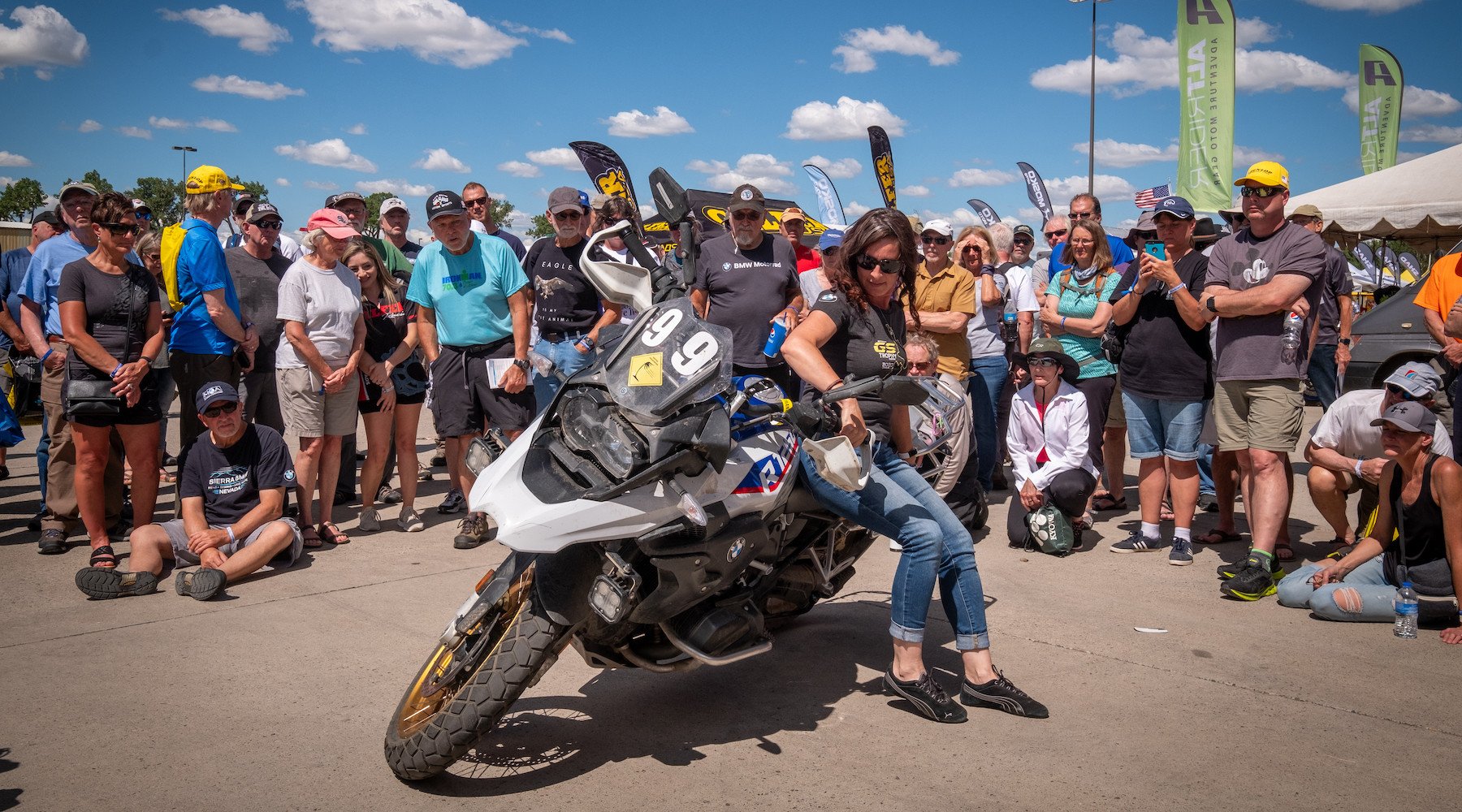For the first time in many years, I hurt myself on a motorcycle. More accurately, I hurt myself standing over a motorcycle—on one foot! I’d just returned from an exhilarating ride on the sinewy North Carolina backroads surrounding the MOA’s annual Fontana Getaway and had positioned my bike strategically within the severely sloped parking space directly outside my room at the lodge. I needed my side stand pointed downhill; any other arrangement would leave the bike precariously balanced without enough lean. Of course, this meant it tilted further than normal when resting securely on the grade—a tad tricky, but no big deal; I’d been in and out of this spot several times already, and since I live in a very hilly area, such compensatory measures are quite familiar to me.

In a split-second lapse I can only assume was some sort of senior moment, I forgot to deploy said side stand before starting my dismount sequence, a sin I’d never committed in over half a century of riding. I had all my weight on my left foot and was leaning the motorcycle (downhill) to the left, expecting it to stop at a deeper angle than usual. By the time I realized my bike had passed the point where it should have found support, it had also passed the point of no return.
The “time expansion” phenomenon kicked in. This is well-known to anyone who’s experienced a fleeting crisis in surreal slow-motion. I discerned what had happened (or rather, what hadn’t happened), I watched with horror as my bike continued its decent toward the ground, I panicked about the expensive damage about to reduce the value of a motorcycle I planned to put up for sale the following week, and then I launched a fervent campaign to save my machine from contact with the pavement—all in a few milliseconds. Given I had zero leverage in my awkward position, this desperate attempt was utterly futile and the motorcycle touched down despite my heroic straining.
Consider several bits of relevant context. First, this was a small motorcycle—BMW’s diminutive G 310 R, set up as a track day toy with all non-essential parts removed (including the hefty catalytic converter and OEM muffler)—so it wasn’t completely insane to think I might successfully intervene. Its scant 320-odd pounds were still resting primarily on the tire contact patches, and it hadn’t gone but about 10 degrees beyond where the side stand would have stopped it when I felt something was amiss. My regular gym workout includes deadlifting over half the 310’s weight, so this would have been within my bodily ability, if not for my glaringly obvious problem with bodily position. Indeed, I’d gently leaned this bike all the way to the ground before (on soft grass) to see exactly where all the contact points would be. I’d easily hoisted the whole thing back up to vertical using proper technique in a crouched stance beside the motorcycle, not straddling it. I knew better!
I certainly would never try to lift weights with the ridiculously bad form I impulsively employed in my panic, since I’d fully expect doing so to result in significant injury—which of course it did. With all the weight (me plus that of the falling motorcycle) on my extended left leg and my body hinged only at the hip, the sudden, off-kilter muscular demand yanked my left hamstring violently. I was forced to limp around the Getaway for the rest of the weekend, gingerly and painfully crabwalking a few steps at a time up and down Fontana Resort’s many steep hills on my way to and from various activities. I hope no one interpreted my episodic wincing as a reaction to our conversation!
The second factor to keep in mind is this bike had been thoroughly outfitted with crash protection, as it was the one in my stable I’d deemed most likely to hit the tarmac. I used it for low-speed parking lot drills and blitzing the tightest local twisties, two activities that posed relatively high risk of a fall, although no such event had yet occurred. I’d installed sliders on the bar-ends, front axle and swingarm, as well as burly crash bars designed for the GS version, so there was really no reason for any concern about damage from tipping over at a standstill. Again, I knew better!
The Ride Inside with Mark Barnes is brought to you by the MOA Foundation. You can join the BMW Motorcycle Owners of America quickly and easily to better take advantage of the Paul B Grant and Clark Luster programs mentioned in this episode.
Finally, I’ve had plenty of practice dealing with falling motorcycles, albeit all off-road. I hadn’t dropped a street bike before, but I’ve lost my balance countless times on slow, technical trails, riding tall dirt bikes on wildly uneven terrain. I know to step away from my toppling mount (always heavily armored in anticipation of such inevitable eventualities) to preserve my skeletal integrity; I trust the bike to take care of itself. Need I say it a third time? I bleepin’ knew better!!
All that to say this: If we chalk up my side stand neglect as a long-overdue instance of unremarkable absentmindedness instead of a sign of serious cognitive decline, how can we account for the unjustified and far more consequential errors of A) struggling to save a perfectly well-protected motorcycle from harm; B) total disregard for the impossible geometry of my bodily configuration; and C) apparent amnesia regarding a vast history of similar experiences and related self-protective habits firmly established by extensive repetition? I choose to understand what happened as a type of reflex.
Reflexes bypass intellectual processing. Try to will your leg to stay still when the physician’s hammer strikes just beneath your knee cap. You’ll find the patellar reflex a formidable opponent for your conscious intent. Likewise, unless you’ve worked very hard to overcome this, you’ll blink (and probably turn your head) when something approaches your face quickly, no matter what you intend to do. Keeping your eye on the ball isn’t as easy as it sounds, nor is popping in a contact lens. Ever leapt away from a “snake” in the woods only to realize seconds later it was merely a fallen branch? These are all neurological circuits that bypass cognitive management (the patellar reflex loops through the spinal cord without even bothering to visit the brain!). Some reflexes developed to help keep us safe, as conscious assessment and planning would slow our response to the point we’d get hurt before we could formulate and take evasive action. Better to leap first and ask questions later.

There are “hardware” reflexes prewired in our central nervous systems. We don’t have to learn these; they’re automatic. If we want to modify them, they have to be unlearned, which typically requires a great deal of practice and perseverance, since hardware isn’t readily altered by “software.” In this metaphor, I’m using “software” to refer to the relatively more flexible, reprogrammable domain of rational thought and deliberate intentions. As in computing, hardware can pose some problems impossible for software to solve, but in other cases a software workaround is possible. Whether developing the ability to not flinch as the pitcher’s fast ball approaches us at home plate, or learning to apply a touch more throttle instead of stabbing at the ground with a foot when we feel our motorcycle lose altitude in a U-turn, we all have experience trying to override a natural (hardware) reflex.
We’ve all also had to install (unnatural) software reflexes where there were none, or when the hardware reflex was problematic, as in the U-turn example just mentioned. In that situation, it’s inadequate to simply stop the automatic action of our leg and foot; we must also replace that with a subtle twist of the wrist. After enough practice, this becomes our thought-free reflexive response to sensing the motorcycle’s imminent fall during a low-speed maneuver; new, consciously chosen software has effectively superseded our old default “stock” hardware.
What about competing software options? This is where I think things went haywire in my side stand fiasco. Although I wasn’t preoccupied with some nagging worry or exciting hope, I was engaged in a little somber reverie knowing my enjoyment of the 310’s giggle-inducing featherweight agility could soon end if it sold promptly. Perhaps this was all the distraction my aging brain needed to yield a side stand deployment failure, especially amidst a routine parking chore I’d assumed could be completed without my careful attention. In addition to distraction, there was the element of surprise. I was caught off-guard—and off-balance!—by the side stand’s unexpected absence; this was an unprecedented emergency for which I had no prepared response. My software already had two strikes against it when it was called upon to problem-solve.
With my last thought having been this motorcycle’s approaching sale, the reflexive priority first in line was avoiding damage so close to putting it on the market. If I’d dropped this bike doing full-lock circles in a parking lot soon after installing those crash bars last year, my confidence in its armor would have undoubtedly been more salient. This would have reduced my alarm about potential harm and brought to mind associations from my off-road mishaps, wherein the priority was saving my body, not the bike. While these thoughts wouldn’t necessarily have been fully conscious, they’d have been closer to consciousness, with the related software programs higher up in the queue. The reflex to simply step away from the bike would have been more likely to emerge victorious against the reflex to prevent imaginary harm. Since installing the crash protection, I’d taken it for granted and barely remembered it was there, so that whole set of ideas was further away from conscious consideration (and action), allowing the fresher concern with resale value to prevail.

We all know the importance of muscle memory in riding skill development. When we have to think about braking technique or evasive maneuvering, precious time is lost and we’re much closer to disaster by the time we act. We need our practice sessions to create and strengthen neuronal pathways—new reflexes—that automatically connect our muscles to our intentions without conscious thought; the understanding of how to do things gets transferred from mind to body. We desire a sudden stop and our well-trained muscles make it happen, no thinking required. This same lack of reflection works against us if the activated reflex is ill-suited to the situation.
When we encounter a novel challenge, we’re apt to either freeze or insert a reflexive action associated with what is front-of-mind at that moment. This is part of why wandering thoughts can be so dangerous on a motorcycle. Not only do they distract us from the current situation, they also pull associated themes closer toward consciousness—themes that may be misaligned with the most critical aspects of an immediate challenge, and therefore prompt an inappropriate reflexive response. Our software reflexes aren’t as reliable as those built into our hardware; they’re much more vulnerable to faulty substitution. So, we should keep the possibility we’ll need to brake hard or take an escape route front-of-mind as we approach a busy intersection, the potential need to swerve around a hidden obstacle should be front-of-mind as we enter a blind corner, and so on. The program we have loaded in consciousness is the one we’re most likely to run reflexively, for better or worse.
Focus is a vital necessity, all the way through the end of each ride.
Mark Barnes is a clinical psychologist and motojournalist. To read more of his writings, check out his book Why We Ride: A Psychologist Explains the Motorcyclist’s Mind and the Love Affair Between Rider, Bike and Road, currently available in paperback through Amazon and other retailers.


